When you ask “How many backlinks do I need to rank for this keyword?”, do you mean how many referring domains or how many backlinks?
Not sure what the difference is?
If so, this article is for you!
In the next 9 minutes, you will learn the difference between referring domains and backlinks, which of them matters more for SEO, and how to increase their numbers.
Are Backlinks And Referring Domains The Same?
A simple answer: no.
Let me explain why.
What are backlinks?
Backlinks are hyperlinks from external sites pointing to your page or website.
Here’s an example of a backlink to our website in a Hubspot article about creative link-building strategies.
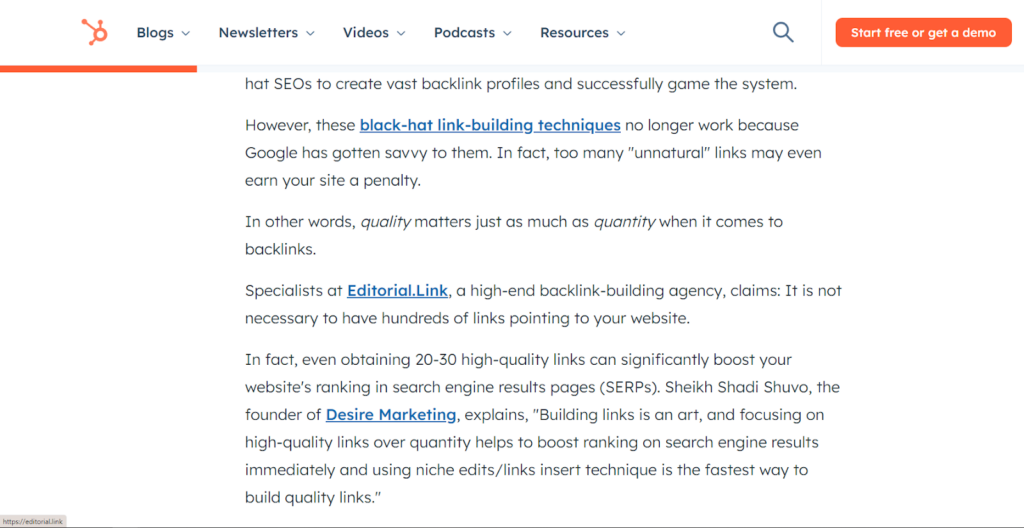
In total, there are currently over 1.7K live backlinks pointing to our website.

What are the referring domains?
Referring domains are the unique websites that link to your website or webpage.
As mentioned, our website backlink profile has 1700 backlinks at the moment, but they come from “only” 592 referring domains. So that’s 592 different websites linking to our pages.
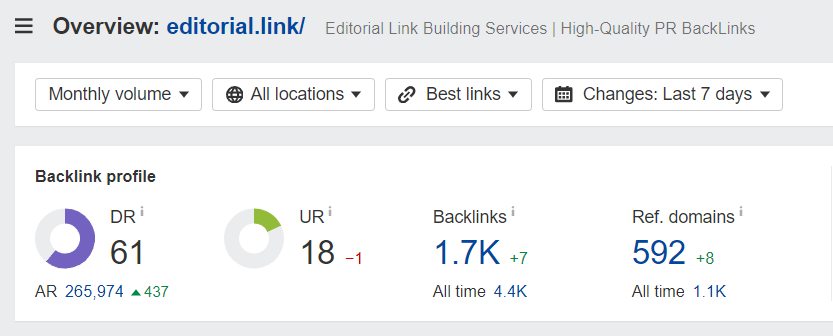
This means that some of the domains have linked to it more than once. With 1.7K links and 592 unique domains, that’s just under three links per domain.
For example, we have two backlinks from Hubspot.

For Backlinko, the ratio is over 11:1, and for Ahrefs —471:1!
It’s safe to assume that the number of backlinks is usually higher than the number of referring domains.
How to Find Referring Domains and Backlinks?
To find the number of referring domains and backlinks, you need an SEO tool.
In Ahrefs, you get the figure in the Site Explorer’s Overview.
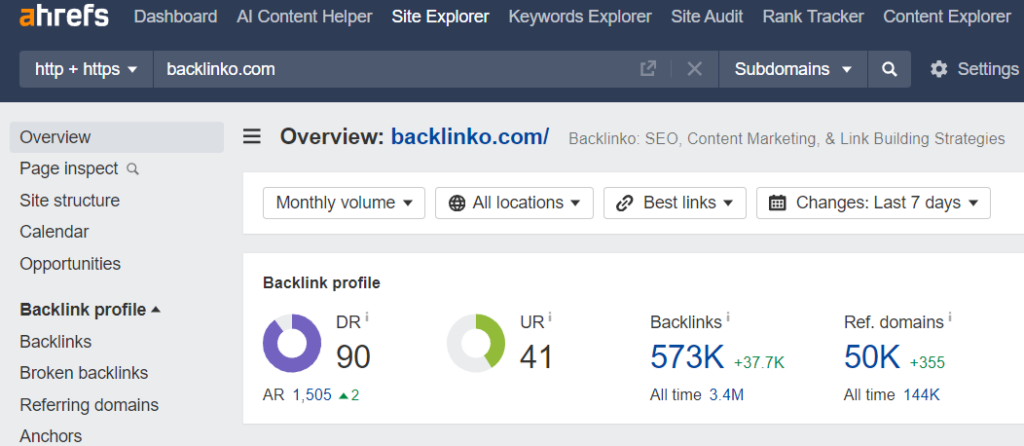
You can also get the count in the Backlinks report by toggling between One link per domain to see the referring domains and All backlinks to see the total link count.

If you have no Ahrefs subscription, you can get the overview from their free Backlink Checker tool, but it doesn’t give you the full list of links.
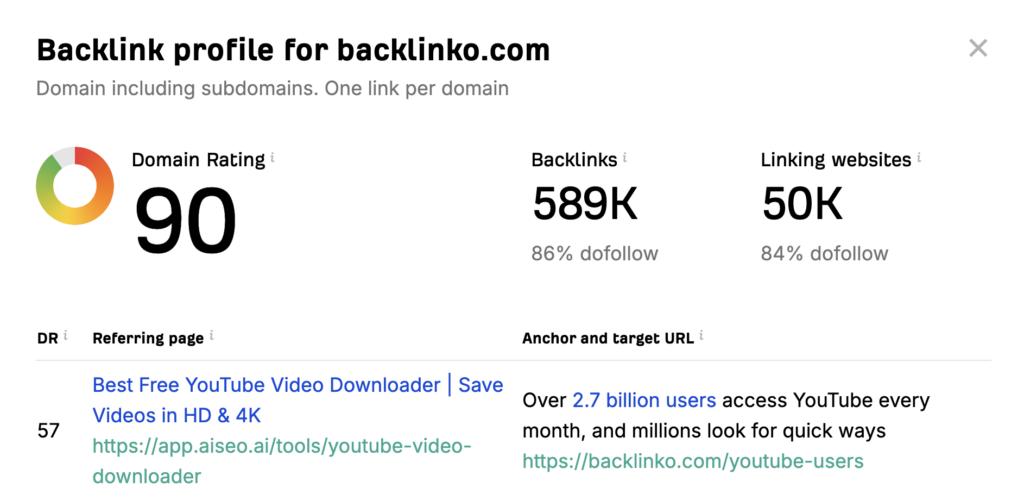
In Semrush, you get the figures in the Domain Overview.
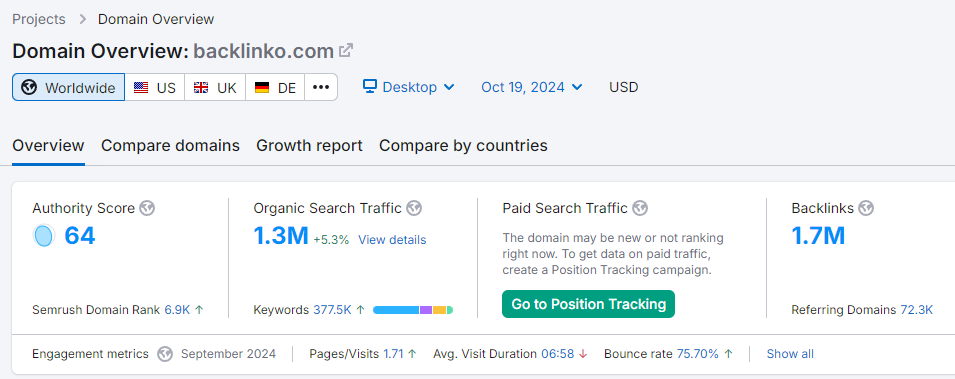
Just like in Ahrefs, more detailed insights are available in the Backlinks report. Semrush allows you to display 1, 3, 10, or all backlinks per domain.
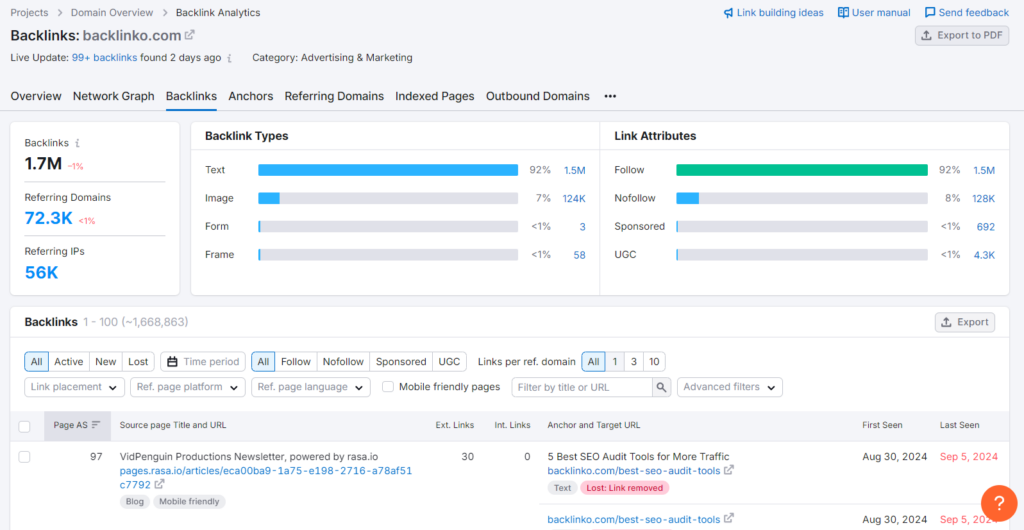
In Moz Pro’s Link Explorer, the Overview report gives you an idea of the total number of backlinks and referring domains.

For more details, head over to the Inbound Links and Linking Domains reports.
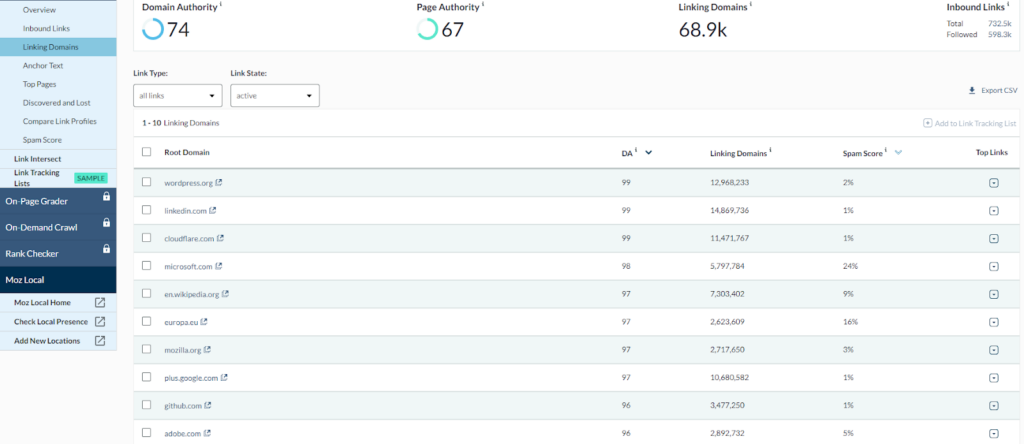
UberSuggest, the free SEO tool, packs all the details into its Backlinks Overview report.
At the top of the page, you can see the scoreboard with the total count of referring domains and backlinks.

When you scroll down, there’s a list of all links, and you can choose to see one link per domain to see the list of referring domains.
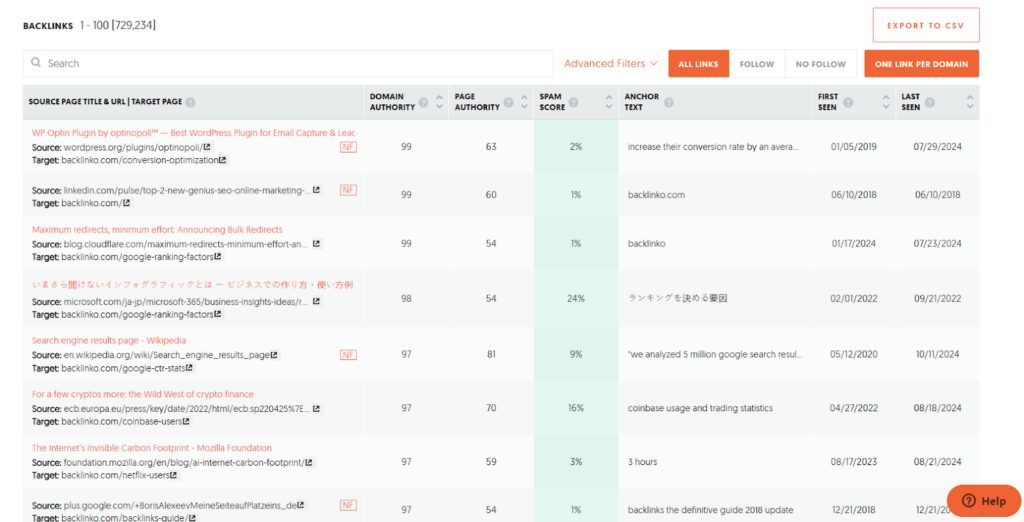
The Impact of Referring Domains and Backlinks on SEO
We all know that backlinks are an important ranking factor. Search engines view them as a signal that the page is of good quality and use the information when serving content to their users. They are like votes of confidence.
Which is more important, the number of backlinks or referring domains?
Picture this:
You’re looking for a new freelance graphic designer. You’ve got two possible candidates. Both have glowing testimonials from their former clients.
One of them has a dozen testimonials but from two clients only. The other has seven testimonials, but they all come from different clients.
Which of them would you consider more trustworthy? The one with testimonials from two clients or the one with testimonials from seven? The one with seven, of course.
The same applies to backlinks.
The more referring domains vouch for you, the more trustworthy you are in the eyes of Google, Bing, and the lot.
That’s why Moz, Semrush, and Ahrefs use the number (and quality) of referring domains and not backlinks to calculate their Domain Authority/Authority Score/Domain Rating metrics.
Ahrefs has also found that the number of referring domains is positively correlated with organic traffic.
If, on the other hand, one of the domains gives you multiple backlinks, their value diminishes.
It doesn’t matter that they’re useless, though.
For example, backlinks from the same domain to multiple articles on your website can still improve their performance as long as they’re relevant.
And if they’re acquired organically, there’s no harm in them. Who would say no to a free link?
However, if you are building links actively and have a limited budget, you will get the most bang for your buck if you target different domains in your campaign.
❗The number of backlinks or referring domains is just one factor to consider. Their authority is way more important. Links from high-quality referring domains pass more link juice. That’s what you need to prioritize over the backlink count.
How to Get Links from More Referring Domains?
Let’s finish with a few link-building tactics you can use to increase the number of referring domains linking to your website.
Conduct original research
Original research reports are one of the best linkable assets. Content writers, journalists, and bloggers are constantly looking for data to help them create more valuable pieces for their audience and increase their authority and credibility.
For example, 58 unique domains are currently linking to our State of Link-Building report, including Toptal Marketing (DR89) and Snov.io (DR80).
Best part?
A few of the 59 domains are our competitors.
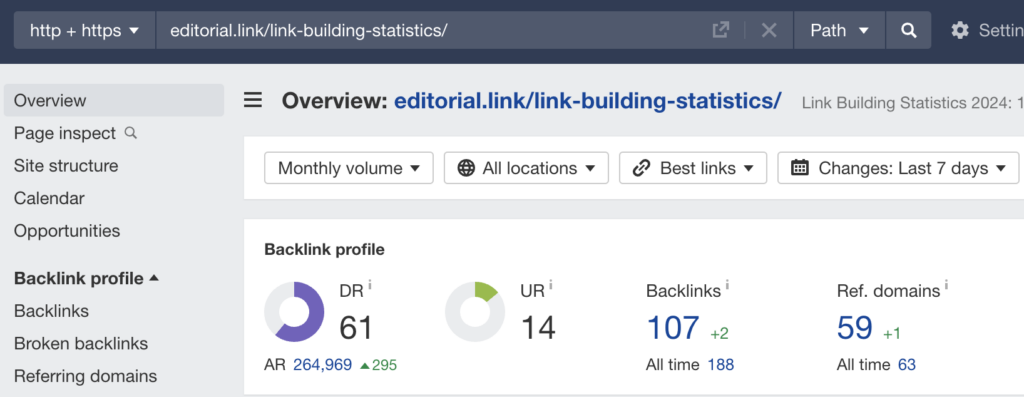
Of course, conducting research and turning the insights into reports requires considerable resources and expertise. Not every business has access to original data they could leverage, and the cost of acquiring it is prohibitive.
The solution?
Create stat round-ups.
This Authority Hacker article with link-building statistics uses multiple sources, not just their own data. And yet, it still has acquired links from 221 domains.
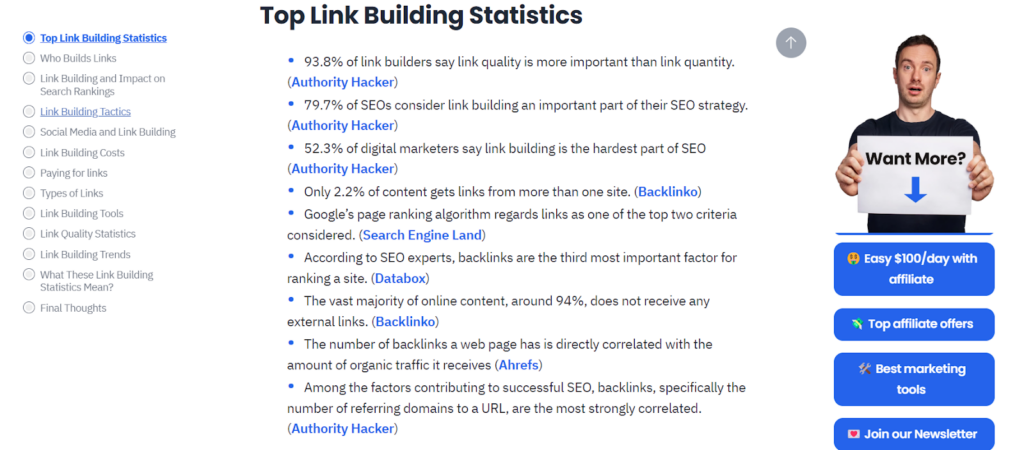
Because here’s the thing:
Writers, no matter how professional and conscientious, don’t always have the time to track down the original source. Such roundups are a very attractive source for them.
💡A pro tip: Boost the link-building potential of your reports by creating infographics based on the research.
Write comprehensive guides
Comprehensive guides are another kind of resource that can earn you dozens of backlinks (if not hundreds or thousands).
For example, Brian Dean’s guide to backlinks has over 6.2K backlinks from 2.3K referring domains, and 6.6K websites have linked to it since it was first published.

What makes ultimate guides such powerful link-magnets?
They provide readers with everything there is to know about the subject in one place. So whenever they write about the subject, this is the first resource they reach for. And the only one they need.
What’s more, such comprehensive content positions you as an authority on the subject, which increases your online visibility and can boost the performance of your other articles in the future.
How do you create an ultimate guide?
Look for popular yet underserved topics
Research keywords related to popular topics like “AI in marketing/SEO/content, etc.” recently, or look for guides that get lots of organic traffic but you can still improve on.
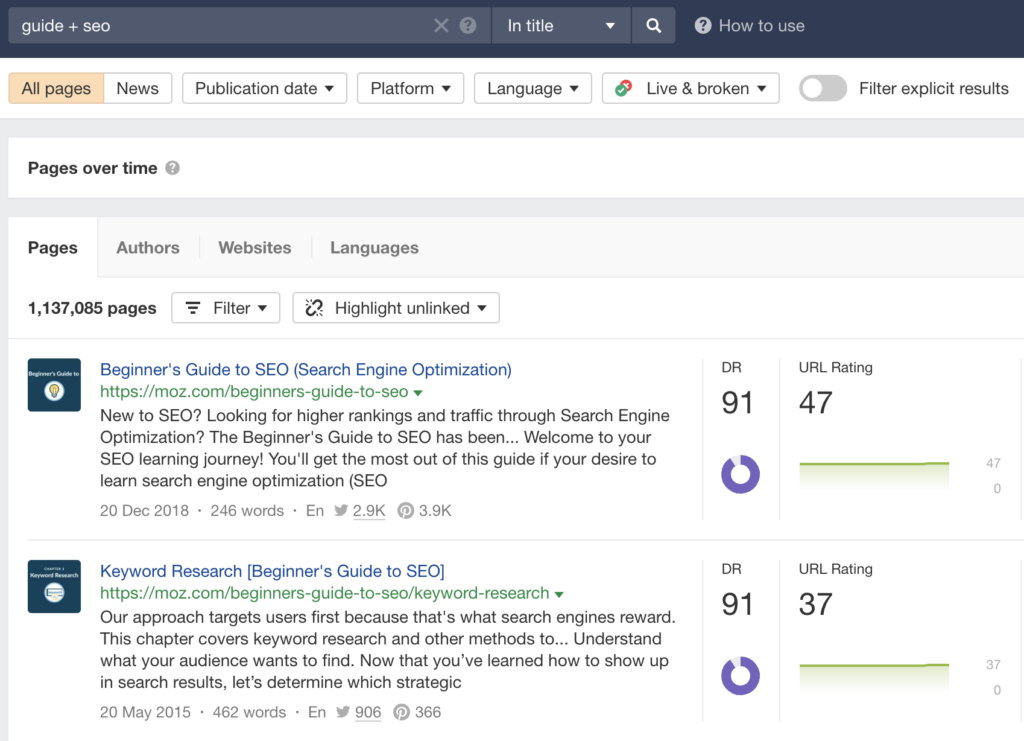
Research the topic thoroughly
Leverage your in-house insights and data, as these are more difficult to replicate. If not, make sure to include real-life examples and case studies to support the insights and strategies you’re offering.
Optimize it for search
Aim for long-tail keywords like ‘how to use AI for search engine optimization.’ Your guide won’t bring you links if users can’t find it.
💡Pro tip: Promote your guides via social media and outreach. If you rely on SEO only, you will get fewer links, and it will take longer.
Run digital PR campaigns
Digital PR has been the wizz kid in the SEO space for the last few years.
There’s a good reason:
A well-executed PR campaign can get you a bunch of quality links from high-authority media outlets.
For example, this campaign orchestrated by Search Intelligence scored 16 backlinks for their client, VPN Overview. These were all from unique domains with DR53-92.
Such links not only elevate your content in search engine rankings but also get it in front of thousands of readers and drive referral traffic.
Start guest posting
Guest posting is when you write a blog post for another website. Such an article usually includes a backlink to your website, so it helps your marketing efforts in two ways: it allows you to reach new audiences and improves your SEO performance.
Guest posting is one of the most popular link-building strategies, but it has its limitations: it’s more challenging to scale than the other tactics. Each domain requires unique content tailored to its audience and editorial guidelines.
We all know how much time and energy it requires, and you need to do tons of prospecting, outreach, and research before you even get to this stage.
Having said that, each guest post can normally bring more than one link. Even if you can link to your site only once, they often allow you to link to other web pages. If these are your partners’ pages, it’s fair to expect links from them as a “token of gratitude.”
Develop your network
Talking of partners: If you’re after unique referring domains, you cannot reuse the same websites again and again. So, never stop building your network.
Here are a few ideas on how to do it:
- Use social media like X or LinkedIn to connect with influencers and companies who share your audience.
- Attend industry conferences.
- Create resource pages and round-ups with links to prospective partners’ content. Offering value upfront builds a foundation for future collaboration.
Build your reputation
Finding new link-building partners is way easier if you’re an authority or a thought leader in your space. Often, the opportunities find you.
For example, Irina Maltseva, the Head of Growth at Aura, often gets requests for quotes and comments from writers in exchange for quality backlinks.
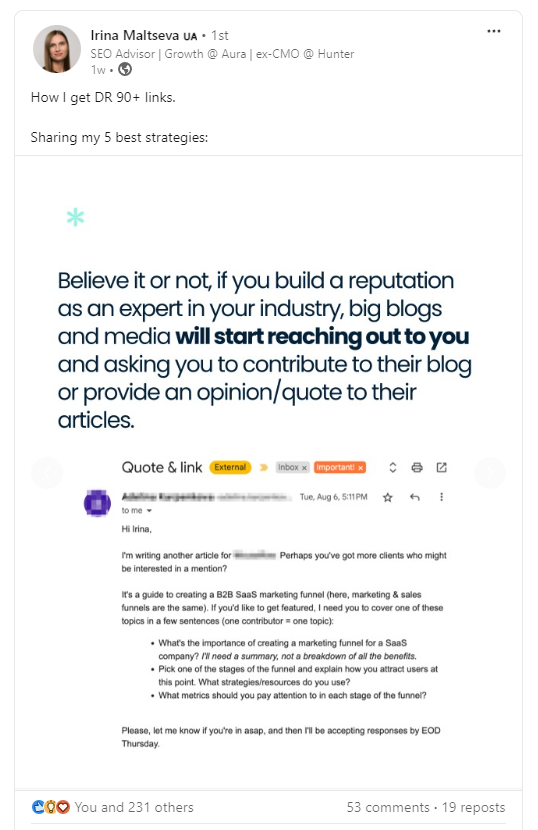
How do you build your authority?
- Publish high-quality content showcasing your expertise (as above).

- Take part in interviews and podcasts.
- Speak at conferences and webinars.
- Share your expertise and engage with your audience on social media.
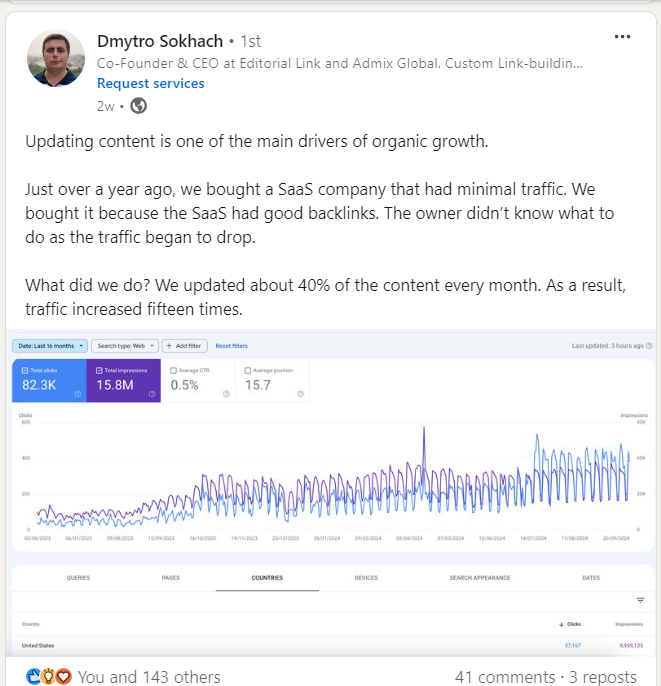
Final Words
Knowing the difference between backlinks and referring domains is essential for a successful SEO strategy.
When SEOs say that they need more backlinks to improve their search engine rankings, they really mean backllinks from more referring domains. That's because links from unique referring domains count more than links from the same domain.
But only if they’re high-quality referring domains.
The main challenge for many link-builders is finding unique referring domains. This becomes increasingly more difficult from campaign to campaign.
That's where reputable link-building agencies have the edge over in-house teams: they have well-developed networks of partners they can lean into to deliver links for their clients.
If you're struggling to find new link-building prospects of the right quality, get in touch with the Editorial.Link team!

